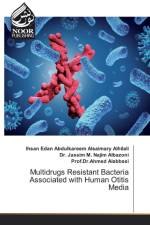von Ihsan Edan Abdulkare Alsaimary Alhilali, Dr Jassim M Najim Albazoni & Prof Dr Ahmed Alabbasi
22,00 €
Gram's negative bacteria were the commonest microorganisms;it comprises (60 %). Pseudomonas aeruginosa was common causative agent (19.04%), followed by Staphylococcus aureus (16.7%) and Klebsiella spp.(14.3%). Mixed infection was found in high percent (74%), in which Pseudomonas aeruginosa and other microorganisms were more common . The antibiotic sensitivity pattern showed that Pseudomonas aeruginosa was sensitive to Ciprofloxacin, amoxicillin + clavulanic acid and gentamicin, while other is appeared resistant, Staph. aureus was sensitive to ciprofloxacin, amoxicillin + clavulanic acid, erthomycin, cephalexine and it is resistant to pencillin and ampicillin, klebsiella species were sensitive to ciprofloxacin, amoxicillin + clavulanic acid, gentamicin, while resistant to tetracycline. Geographical distribution, 100 (84%) of patients with CSOM living in urban area, 20(16.7) living in rural area . Smoking and passive smoking, 30(25%)smoker patients, 80(75%) non smoker, while 63(52.5%) patients with CSOM suffering from passive smoking. Distribution of feeding type among infants and children with CSOM 20(16.66%) breast feeding, while 10(8.33%) bottle feeding.

